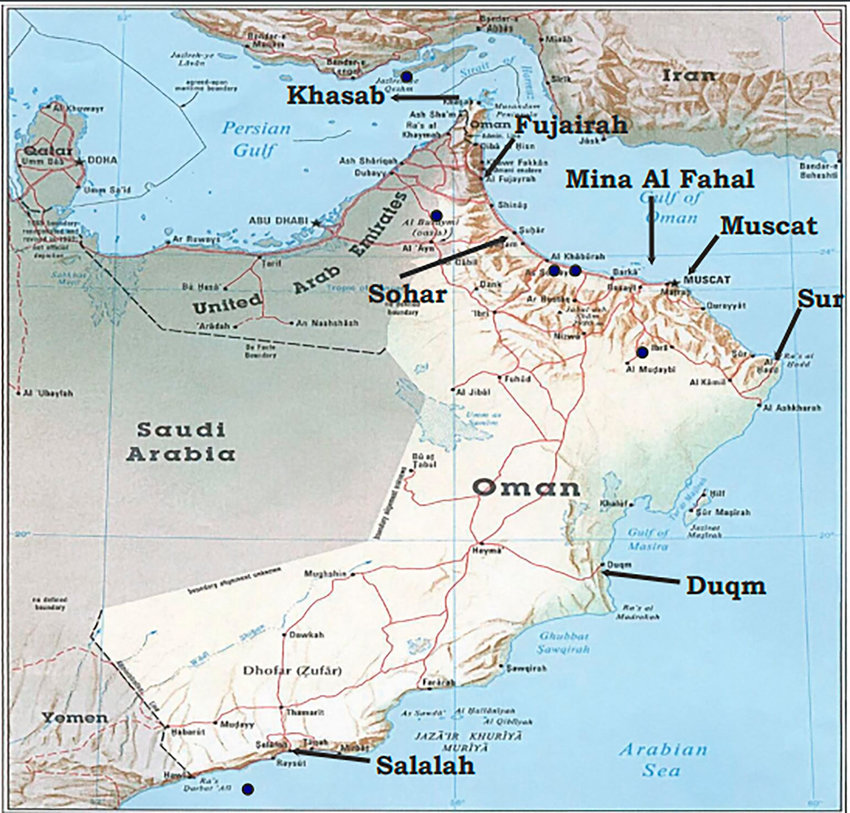Oman’s coastline boasts rich mineral and gas deposits, making it a strategic location along the Gulf of Oman. Utilizing the Arabian Sea for container and oil tanker traffic, Oman’s major ports play a vital role in global trade.

The trade volume in Oman amounts to billions of dollars annually, primarily driven by oil cargo, followed by container and finished goods trade. This underscores the importance of seamless cargo exchange for Oman’s industrial development.
To support this thriving sector, thousands of vessels dock at Oman’s shores each year, with the majority engaged in international cargo freight, particularly with neighboring UAE.
Let’s delve into the five major ports of Oman, exploring their trade features, geographical characteristics, and cargo handling capabilities.
Port of Salalah (Dhofar Governorate, Oman)
The Port of Salalah, established in 1998, operates under the authority of Salalah Port Services. Known for its efficiency, it ranks as one of the fastest container handling terminals globally. With six large-size berths, the port handles millions of TEUs annually, supported by modern infrastructure and equipment.
Cargo Handling: Salalah’s container handling peak surpasses millions of TEUs, facilitated by advanced cranes and deep alongside depth.
Network and Layout: Employing over 2200 local staff, the port boasts extensive facilities, including a cruise terminal, with plans for further expansion.
Port of Sultan Qaboos (Muscat, Oman)
Formerly a bustling cargo hub, the Port of Sultan Qaboos is transitioning into a cruise facility. Despite current inactivity, it has a rich history of cargo handling, featuring significant grain and cement operations.
Cargo Handling: Notable for its grain and cement handling facilities, the port’s infrastructure supports various cargo operations.
Network and Layout: Amidst ongoing transformations, plans for a passenger terminal conversion aim to enhance tourism prospects.
Port of Duqm (Al Wusta Region, Oman)
A relatively new addition, the Port of Duqm has quickly become a profitable venture. Operating within a special economic zone, it serves as both a commercial port and a defense base, fostering collaborations with international partners.
Cargo Handling: Offering drydocking services and multipurpose cargo handling, Duqm’s facilities cater to diverse maritime needs.
Network and Layout: With extensive quay lengths and dry bulk cargo handling areas, Duqm is poised for further growth and expansion.
Port of Sohar (Al Batinah Region, Oman)
As the second-largest port in Oman by cargo volume, the Port of Sohar handles millions of metric tons of cargo annually. Jointly operated with the Port of Rotterdam, it benefits from a free zone status, attracting global shipping investors.
Cargo Handling: Specializing in bulk cargo operations, Sohar features advanced facilities for efficient handling of various commodities.
Network and Layout: With a significant workforce and shared operational stakes, Sohar’s strategic location enhances its appeal for trade.
Port of Qalhat (Ash Sharqiyah Region, Oman)
Primarily a LNG handling facility, the Port of Qalhat plays a crucial role in Oman’s gas exports. Equipped with modern safety standards, it facilitates gas carrier operations with global partners.
Cargo Handling: Focused on LNG exports, Qalhat’s infrastructure supports safe and efficient handling of gas carriers.
Network and Layout: Operating within a specialized LNG storage and handling facility, Qalhat contributes to Oman’s industrialization efforts.


Latest Products
8-inch Color TFT LCD GPS Chart Plotter with EchoSounder, AIS Transponder, and Radar MFD (5-in-1)
8-inch GPS Chart Plotter with AIS and Radar
Onwa KM-8A (BUNDLE) 8-inch Color TFT LCD GPS Chart Plotter with Class B+ AIS Transponder MFD [BUNDLE]
Onwa KM-8C 8-inch Color TFT LCD GPS Chart Plotter with EchoSounder MFD